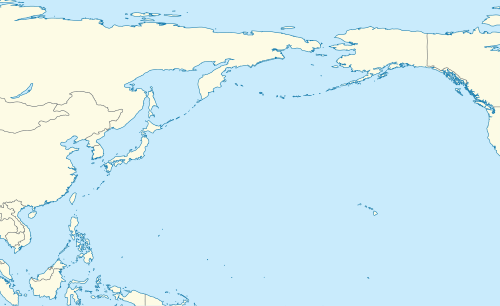Mount Suribachi
| Suribachi | |
|---|---|
|
Aerial view of Mount Suribachi, photographed in 2001 | |
| Highest point | |
| Elevation | 169 m (554 ft) [1] |
| Coordinates | 24°45′01″N 141°17′20″E / 24.75028°N 141.28889°ECoordinates: 24°45′01″N 141°17′20″E / 24.75028°N 141.28889°E |
| Geography | |
| Parent range | Volcano Islands |
| Geology | |
| Mountain type | Cinder cone |
| Volcanic arc/belt | Volcano Islands |
| Last eruption | May 2, 2012[1] |
Mount Suribachi (JPN.: 摺鉢山, Suribachiyama) is a 169 m high mountain at the southwest end of the island Iwo Jima (now officially Iō-tō) in the northwest Pacific Ocean, under the administration of Ogasawara Subprefecture, Tokyo Metropolis, Japan.
The mountain's name derives from its shape, resembling a suribachi or "grinding bowl." It is also known as the "Mount Pipe" (JPN: パイプ山, paipu-yama), since the sulfur gas and water vapor that rolls in from the summit, alongside the rest of the island, give the appearance of a smoking pipe when viewed from the sea.
Joe Rosenthal's famous photograph Raising the Flag on Iwo Jima was taken at the mountain's peak.
Geology
Geologically, the mountain is a cinder cone of andesite, formed by volcanic activity. It is thought that the mountain is a dormant vent to a still active volcano (designated Iō-tō, the name of the island as a whole). Most recently, the Japanese Meteorological Agency reported that on May 2, 2012, a small eruption caused water discoloration to the northeast, and confirmed the appearance of a new fumarole.[1]
From 1889 to 1957, the Japanese government recorded 16 eruptions on the peak. This eruption lasted for 65 minutes, and created a crater with a diameter of 35 meters and a depth of 15 meters on the runway near the former World War II airfield.[2]
History
During World War II, the Japanese built underground tunnel and bunker systems in and on Mount Suribachi. In the spring of 1945, the major battle between Japan and the United States broke out. For the United States, Iwo Jima was an important strategic point between the United States and the Japanese empire, a status that resulted in severe fighting that took the lives of nearly 7,000 Americans and 20,000 Japanese.
The films Letters from Iwo Jima and Flags of Our Fathers, directed by Clint Eastwood in 2006, treat the theme of this Pacific battle and represent the positions of both belligerents in this conflict. The film Sands of Iwo Jima, directed by Allan Dwan and starring John Wayne in 1949, follows a United States Marine squad preparing for battle at Iwo Jima.
References
- 1 2 3 "Ioto". Global Volcanism Program. Smithsonian Institution.
- ↑ Fisherl, Richard Virgil; Grant Heiken; Jeffrey B. Hulen (1997). Volcanoes: Crucibles of Change. Princeton University Press. ISBN 0-6910-0249-5.
External links
"Ioto". Global Volcanism Program. Smithsonian Institution.
